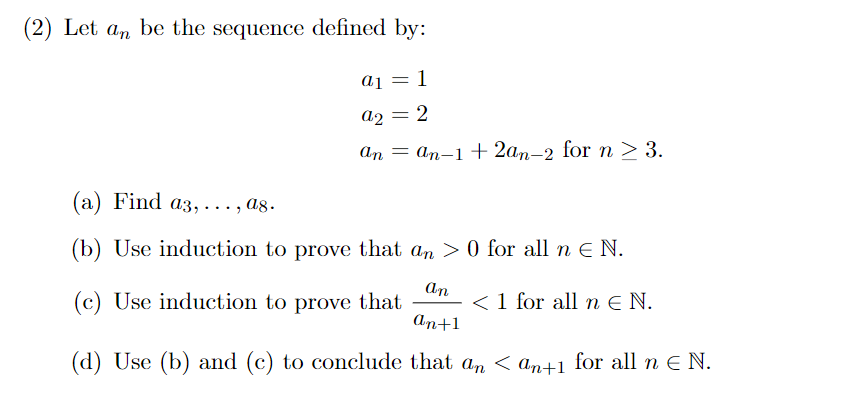(2) Let an be the sequence defined by: a₁ = 1 a2 = 2 an an-1 + 2an-2 for n ≥ 3. (a) Find a3,..., as. (b) Use induction to prove that an> 0 for all n € N. an < 1 for all n EN. (c) Use induction to prove that an+1 (d) Use (b) and (c) to conclude that an
(2) Let an be the sequence defined by: a₁ = 1 a2 = 2 an an-1 + 2an-2 for n ≥ 3. (a) Find a3,..., as. (b) Use induction to prove that an> 0 for all n € N. an < 1 for all n EN. (c) Use induction to prove that an+1 (d) Use (b) and (c) to conclude that an
Elements Of Modern Algebra
8th Edition
ISBN:9781285463230
Author:Gilbert, Linda, Jimmie
Publisher:Gilbert, Linda, Jimmie
Chapter2: The Integers
Section2.2: Mathematical Induction
Problem 53E: Given the recursively defined sequence a1=0,a2=30, and an=8an115an2, use complete induction to prove...
Related questions
Question
(2) Let a(n) be the sequence defined by:
a1 = 1
a2 = 2
an = an−1 + 2an−2 for n ≥3.
(a) Find a3, . . . , a8.
(b) Use induction to prove that an > 0 for all n ∈N.
(c) Use induction to prove that an/an+1 < 1 for all n ∈N.
(d) Use (b) and (c) to conclude that an < an+1 for all n ∈N.

Transcribed Image Text:(2) Let an be the sequence defined by:
a1 = 1
a2 = 2
an an-1 + 2an-2 for n > 3.
(a) Find a3,..
(b) Use induction to prove that an > 0 for all n € N.
(c) Use induction to prove that
< 1 for all nЄN.
.... ag.
an
an+1
(d) Use (b) and (c) to conclude that an < an+1 for all n € N.
Expert Solution
This question has been solved!
Explore an expertly crafted, step-by-step solution for a thorough understanding of key concepts.
This is a popular solution!
Trending now
This is a popular solution!
Step by step
Solved in 2 steps with 2 images

Recommended textbooks for you

Elements Of Modern Algebra
Algebra
ISBN:
9781285463230
Author:
Gilbert, Linda, Jimmie
Publisher:
Cengage Learning,


Algebra & Trigonometry with Analytic Geometry
Algebra
ISBN:
9781133382119
Author:
Swokowski
Publisher:
Cengage

Elements Of Modern Algebra
Algebra
ISBN:
9781285463230
Author:
Gilbert, Linda, Jimmie
Publisher:
Cengage Learning,


Algebra & Trigonometry with Analytic Geometry
Algebra
ISBN:
9781133382119
Author:
Swokowski
Publisher:
Cengage